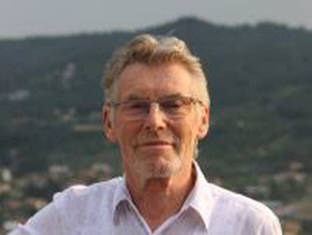(UPDATED) Figuring Out How Life First Took Off Is (like) Rocket Science
Wednesday, Jan 30, 2019 at 7 PM
CLU Gilbert Sports and Fitness Center, 130 Overton Court, rooms 253/254 (second floor)
Life was driven into being on our planet to resolve the disequilibria between the fuels hydrogen and methane emanating from submarine alkaline springs, as against the carbon dioxide and nitric oxide dissolved in the acidulous ocean from the atmosphere. The two fluids were kept at bay by the precipitation of iron minerals at the spring. It was in the mineral barriers that this free energy was first converted via a protometabolism to organic molecules via a layered mineral, green rust, that acted as the simple organization ‘seed for all life’ (Russell, 2018).Thus, we may conclude that life hydrogenated, and still hydrogenates, carbon dioxide. Therefore, we may expect life to emerge on any wet and rocky world that has a partly carbon dioxide-rich ocean.
A pedagogical comparison of emergence-of-life research and rocket science is made in order to inform how environmental disequilibria at the ocean/crust interface on the early Earth forced life’s emergence as an inescapable mechanism for their dissipation. Likely fuels and oxidants to drive life into being were alkaline hydrothermal solutions bearing H2 + CH4 juxtaposed with nitric + carbonic acids carbureted along the outside of a spontaneously precipitated semipermeable metal hydroxide/ sulfide mound. As a comparison, H2 + CH4 can also be used as fuels for rockets, with nitric acid as an oxidant, carefully distributed through the mixing head to the combustion chamber. Whereas a full burn is the goal of the rocket engineer, the first living entities were best served by incomplete reactions and thereby the production of metastable intermediates that could further interact to beat the first metabolic pathway to life. In this analogy the hydrothermal mound is broadly comparable to the rocket while individual engines (cf, ramjets) comprise the variable valence and conformationally flexible mineral, green rust (~[Fe2+4Fe3+2(OH12] 2+[CO3.3H2O]2-), precursor to the first living cells.
Reference
Russell M. 2018. Green Rust: The Simple Organizing ‘Seed’of All Life?. Life, 8(3), 35
https://www.nature.com/news/2009/090520/pdf/459316a.pdf
http://www.mdpi.com/2075-1729/8/3/35/pdf
Dr. Michael Russell
 Dr. Michael Russell is a Principal Scientist at the Jet Propulsion Laboratory, California Institute of Technology where he is testing his theory on the emergence of life. His life has come full circle from his first job as a works chemist in East London, England, testing the activity of nickel catalysts for organic synthesis; attending the University of London to studying geology, chemistry and physics; taking a post at the Solomon Islands Geological Survey to search for submarine hot springs, assess volcanic hazard and explore for mineral deposits and continuing the latter activity in Canada before returning to the University of Durham in the UK to undertake research on the newly discovered giant mineral deposits in Ireland—research that led to his theorizing into the emergence of life at submarine springs. He became the Dixon Research Professor at the University of Glasgow in 1990 and moved to JPL in 2006. Dr. Michael Russell is a Principal Scientist at the Jet Propulsion Laboratory, California Institute of Technology where he is testing his theory on the emergence of life. His life has come full circle from his first job as a works chemist in East London, England, testing the activity of nickel catalysts for organic synthesis; attending the University of London to studying geology, chemistry and physics; taking a post at the Solomon Islands Geological Survey to search for submarine hot springs, assess volcanic hazard and explore for mineral deposits and continuing the latter activity in Canada before returning to the University of Durham in the UK to undertake research on the newly discovered giant mineral deposits in Ireland—research that led to his theorizing into the emergence of life at submarine springs. He became the Dixon Research Professor at the University of Glasgow in 1990 and moved to JPL in 2006.
|

